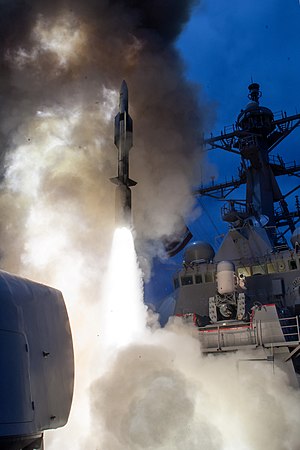RIM-174
| RIM-174 ERAM Standard SM-6 |
|
|---|---|

USS John Paul Jones launches a RIM-174 in June 2014
|
|
| Type | Surface-to-air missile |
| Place of origin | United States |
| Service history | |
| In service | 2013–present |
| Used by |
United States Navy Royal Australian Navy Japan Maritime Self Defense Force Republic of Korea Navy |
| Production history | |
| Manufacturer | Raytheon |
| Unit cost | US$3.5-4 million |
| Produced | 2009–present |
| Number built | 200 (1,800 planned) |
| Specifications | |
| Weight | 3,300 lb (1,500 kg) |
| Length | 21.5 ft (6.6 m) |
| Diameter | 21 in (0.53 m) max. |
| Warhead | 140 lb (64 kg) blast fragmentation |
|
Detonation
mechanism |
radar and contact fuze |
|
|
|
| Engine | Two Stage: Solid rocket booster, solid rocket booster/sustainer |
| Wingspan | 61.8 in (1.57 m) |
|
Operational
range |
~130–250 nmi (240–460 km; 150–290 mi) |
| Flight ceiling | >110,000 ft (34,000 m) |
| Speed | Mach 3.5 |
|
Guidance
system |
Inertial guidance, active radar homing and semi active radar homing |
|
Launch
platform |
surface ship |
The RIM-174 Standard Extended Range Active Missile (ERAM), or Standard Missile 6 (SM-6) is a missile in current production for the United States Navy. It was designed for extended range anti-air warfare (ER-AAW) purposes providing capability against fixed and rotary-wing aircraft, unmanned aerial vehicles, and anti-ship cruise missiles in flight, both over sea and land. It can also be used as a high speed anti-ship missile. The missile uses the airframe of the earlier SM-2ER Block IV (RIM-156A) missile, adding the active radar homing seeker from the AIM-120C AMRAAM in place of the semi-active seeker of the previous design. This will improve the capability of the Standard missile against highly agile targets, and targets beyond the effective range of the launching vessels' target illumination radars. Initial operating capability was planned for 2013 and was achieved on November 27, 2013. The SM-6 is not meant to replace the SM-2 series of missiles, but will serve alongside and provide extended range and increased firepower. It was approved for export in January 2017.
The Standard ERAM is a two-stage missile with a booster stage and a second stage. It is similar in appearance to the RIM-156A Standard missile. The radar seeker is an enlarged version adapted from the AIM-120C AMRAAM seeker (13.5 in (34 cm) versus 7 in (18 cm)). The missile may be employed in a number of modes: inertial guided to target with terminal acquisition using active radar seeker, semi-active radar homing all the way, or an over the horizon shot with Cooperative Engagement Capability. The missile is also capable of terminal ballistic missile defense as a supplement to the Standard Missile 3 (RIM-161). Unlike other missiles of the Standard family, the Standard ERAM can be periodically tested and certified without removal from the vertical launching system.
The SM-6 offers extended range over previous SM-2 series missiles, primarily being able to intercept very high altitude or sea-skimming anti-ship missiles, and is also capable of performing terminal phase ballistic missile defense. It can discriminate targets using its dual-mode seeker, with the semi-active seeker relying on a ship-based illuminator to highlight the target, and the active seeker having the missile itself send out an electromagnetic signal; the active seeker has the ability to detect a land-based cruise missile amid ground features, even from behind a mountain. The multi-mission SM-6 is engineered with the aerodynamics of an SM-2, the propulsion booster stack of the SM-3, and the front end configuration of the AMRAAM. Estimates of the SM-6's range vary; its official published range is 150 mi (130 nmi; 240 km), but it could be anywhere from 200 nautical miles (230 mi; 370 km) to as much as 250 nmi (290 mi; 460 km).
...
Wikipedia
